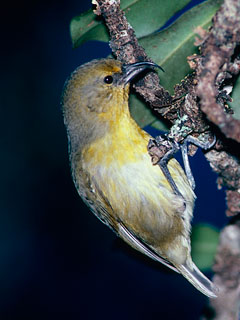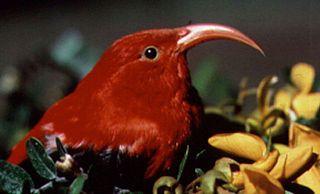Located about 2300 miles (3680 km) from the nearest continental shore, the Hawaiian Islands are the most isolated group of islands on the planet. The plant and animal life of the Hawaiian archipelago is the result of early, very infrequent colonizations of arriving species and the slow evolution of those species—in isolation from the rest of the world's flora and fauna—over a period of at least 5 million years. As a consequence, Hawai'i is home to a large number of endemic species. The radiation of species described by Charles Darwin in the Galapagos Islands which was critical to the formulation of his theory of evolution is far exceeded in the more isolated Hawaiian Islands.

Presbytis is a genus of Old World monkeys also known as langurs, leaf monkeys, or surilis. Members of the genus live in the Thai-Malay Peninsula, on Sumatra, Borneo, Java and smaller nearby islands.

Akialoa is an extinct genus of Hawaiian honeycreeper in the subfamily Carduelinae of the family Fringillidae. The ʻakialoa species are all extinct, but they formerly occurred throughout Hawaii.

The Kauaʻi ʻamakihi is a species of Hawaiian honeycreepers endemic to Kauaʻi in the family Fringillidae. The species Hawaiian name is associated with is Kihikihi, or kihi, which stems from the word amakihi. Kihikihi, meaning curved, makes a reference to the bill of the Kauaʻi ʻamakihi. The Kauaʻi ʻamakihi has similar physical features to an extinct species, the Kauaʻi nukupuʻu. When flying or feeding, the Kaua’i ‘amakihi lets out a distinguishing tweet.

The ʻakiapōlāʻau, pronounced ah-kee-ah-POH-LAH-OW, is a species of Hawaiian honeycreeper that is endemic to the island of Hawaii. Its natural habitats are dry and montane moist forests, and the only bird species on the island to occupy the woodpecker niche. The bird is 5.5 inches (14 cm) in length, and has an unusually curved beak-(a specialist species). The ʻakiapolaʻau is a pudgy bird which has a whitish bottom and tail, black legs, yellow chest, orangish head, black face mask and bill and gray black wings. The male's song is either a loud, short pit-er-ieu or a rapid warba-warba. Its various calls include an upslurred whistle, a short cheedle-ee warble, and a short sweet. Due to the recent disappearance of the Kauai nukupuʻu in the 1900s and the Maui nukupuʻu in the 1990s, leading to fears that they may be extinct, the ʻakiapōlāʻau may be the last of its genus. It is the only member of the subgenus Heterorhynchus, which has a woodpecker-like feeding habitat and exclusively preys on insects, in contrast to the nukupu'us, which were both insect-eaters and also hummingbird-like nectarivores.

The Hawaiʻi ʻamakihi, also known as the common ʻamakihi, is a species of Hawaiian honeycreeper.

Brown doves are members of the genus Phapitreron in the pigeon family. Their common name refers to their overall brown coloration. They are endemic to the Philippines. All brown doves are tree-dwellers, but the different species occupy different types of wooded habitats; some are more restricted to old-growth forest while other make use of secondary forest and other woodland. Their main diet is fruit. They tend to be solitary in their habits and can be elusive. Some species in this genus have conspicuous black and white stripes on their faces and iridescent neck feathers. Males and females look alike.
The giant nukupuʻu is an extinct species of finch in the family Fringillidae, which is only known from fossil remains. It was endemic to Hawaii. Its extinction is believed to have occurred within the last 3000 years, but exact timing and reasons remain unclear. It was larger and had a different bill morphology than the remaining members of the genus Hemignathus.

The Maui nukupuʻu is a species of nukupuʻu Hawaiian honeycreeper that was endemic to the island of Maui in the Hawaiian Islands. The small, five-inch-long bird lived only in eastern Maui, where it was dependent on high-elevation mesic and wet forests of ʻōhiʻa lehua and koa. These two species of trees attract insects, causing the Maui nukupuʻu to have a higher chance of finding a meal near these trees. It was last sighted in the late 1990's, and is most likely extinct.

The Kauaʻi nukupuʻu was a species of nukupuʻu once found throughout parts of the Hawaiian island of Kauaʻi. It was an insect eater that picked out its tiny prey from tree bark. The males were yellowish with brown wings, while the females were grayish brown with a yellow throat streak.

The Oʻahu nukupuʻu is an extinct species of nukupuʻu, a type of Hawaiian honeycreeper native to Oahu, which was similar to its cousins from the Islands of Kauaʻi and Maui. It is yellowish greyish with a long hooked beak to find insects. This bird is now extinct due to human activity.

Hawaiian honeycreepers are a group of small birds endemic to Hawaiʻi. They are members of the finch family Fringillidae, closely related to the rosefinches (Carpodacus), but many species have evolved features unlike those present in any other finch. Their great morphological diversity is the result of adaptive radiation in an insular environment. Many have been driven to extinction since the first humans arrived in Hawaii, with extinctions increasing over the last 2 centuries following European discovery of the islands, with habitat destruction and especially invasive species being the main causes.

Delissea kauaiensis is a critically endangered species of the bellflower family. It is found on Mt. Ha'upu near Hanapepe Falls, and Mahanaloa. It was thought to be extinct, but 10 individuals were found in 2016. It is known as ‘Oha in Hawaiian, and has the English common names of Kauaʻi delissea, KauaʻI leechleaf delissea, and Leechleaf delissea.











